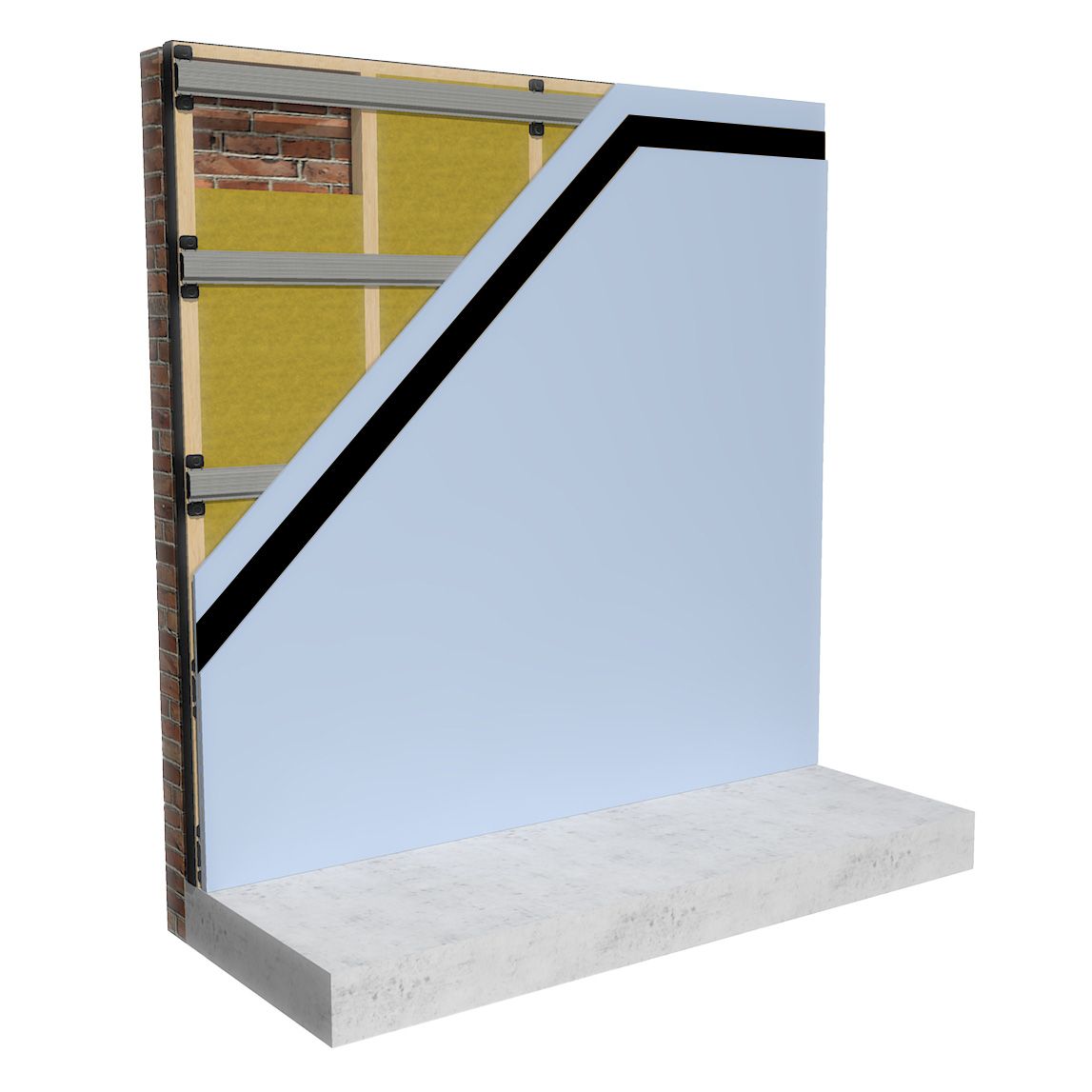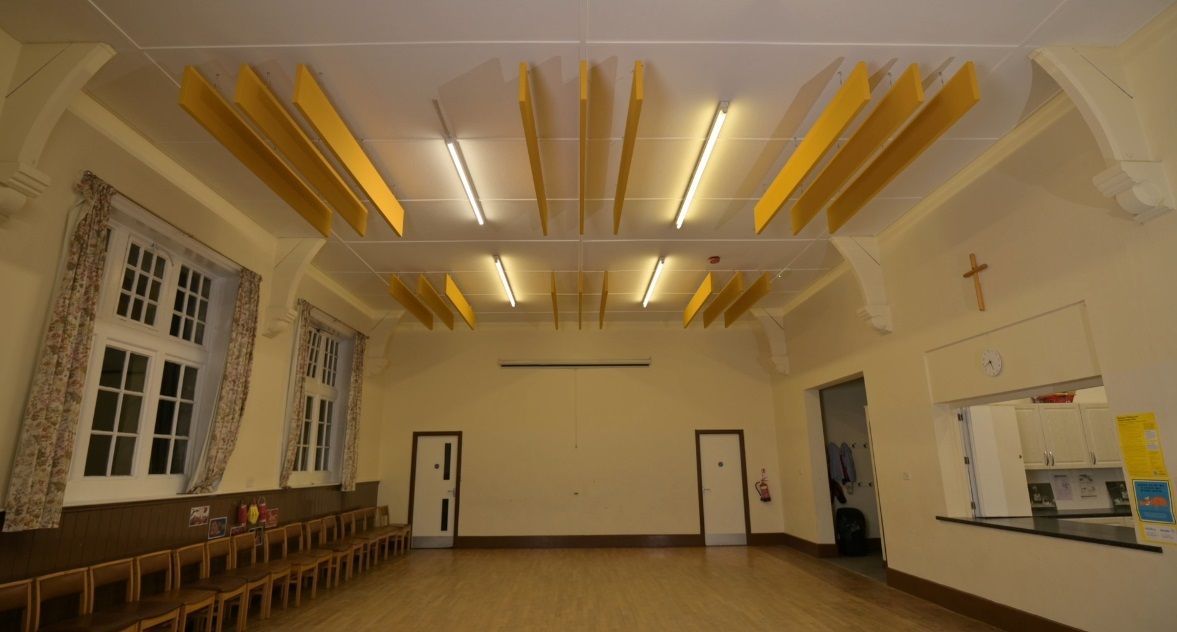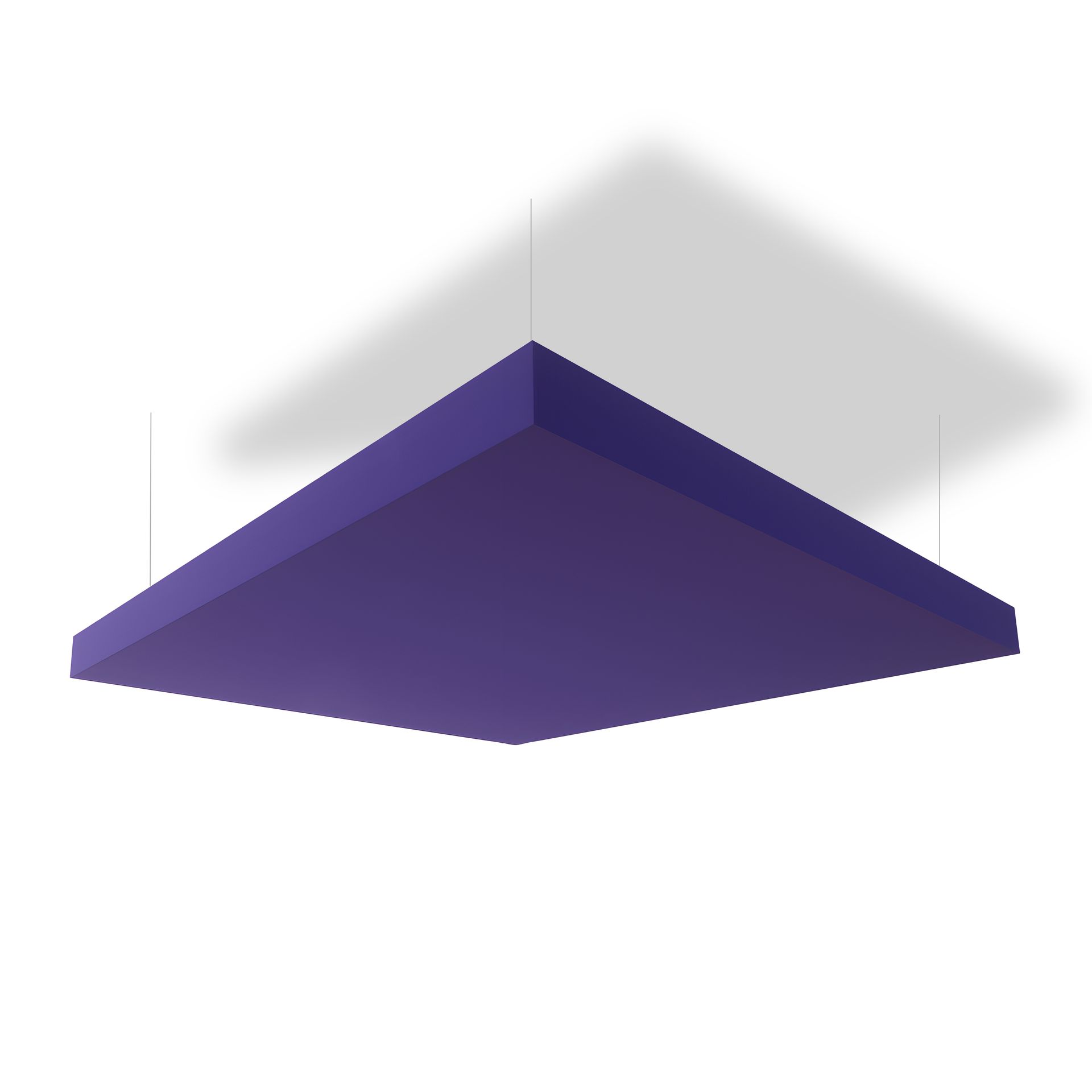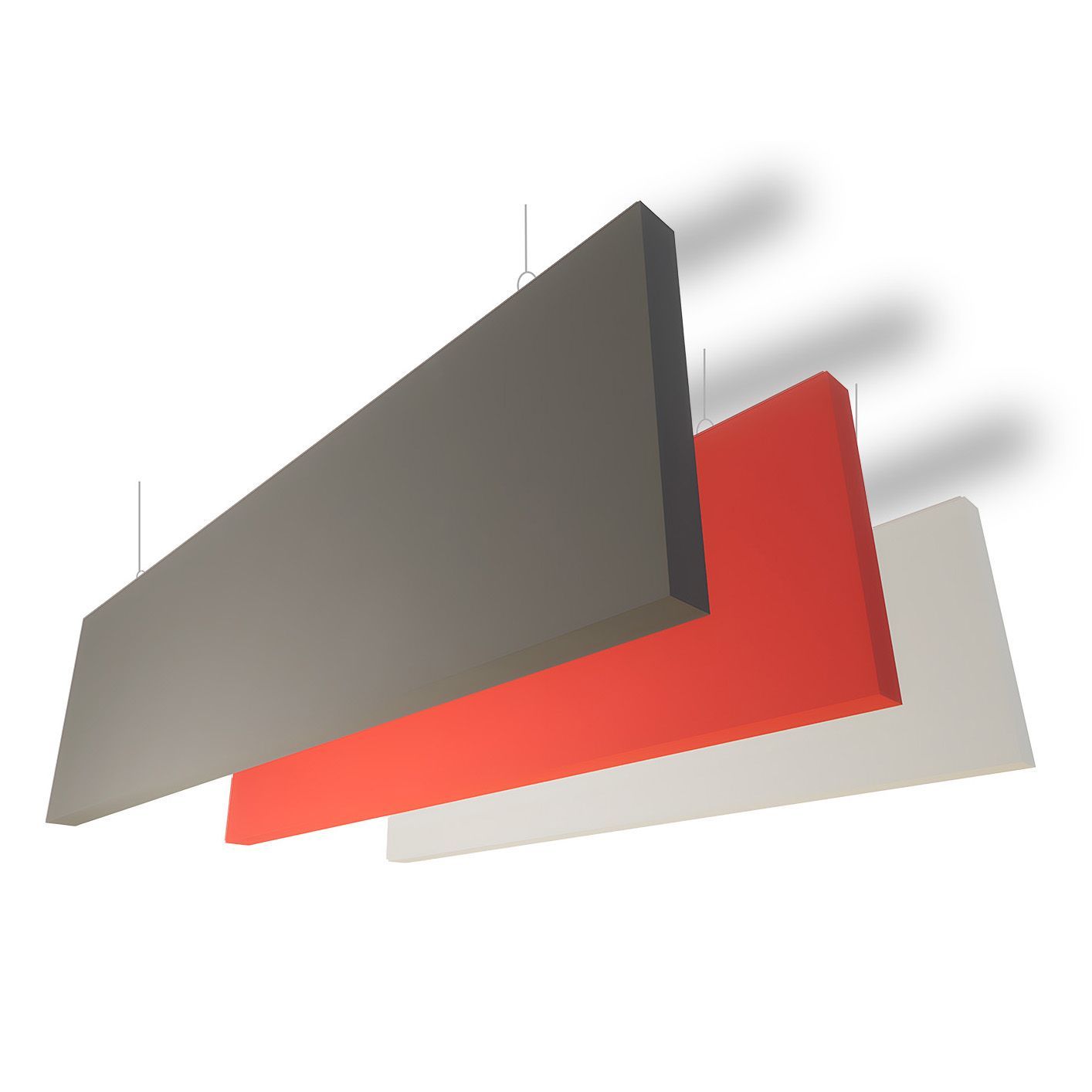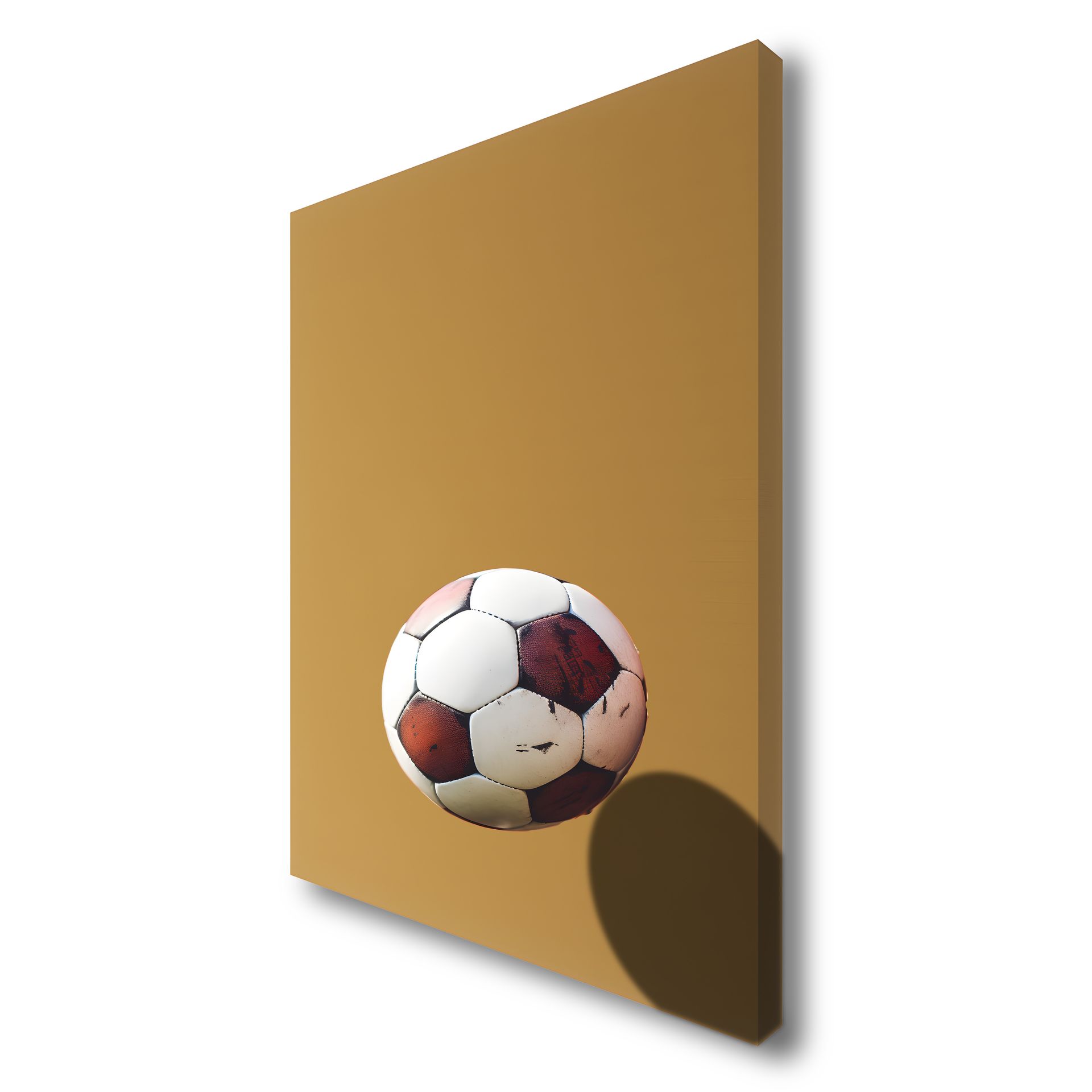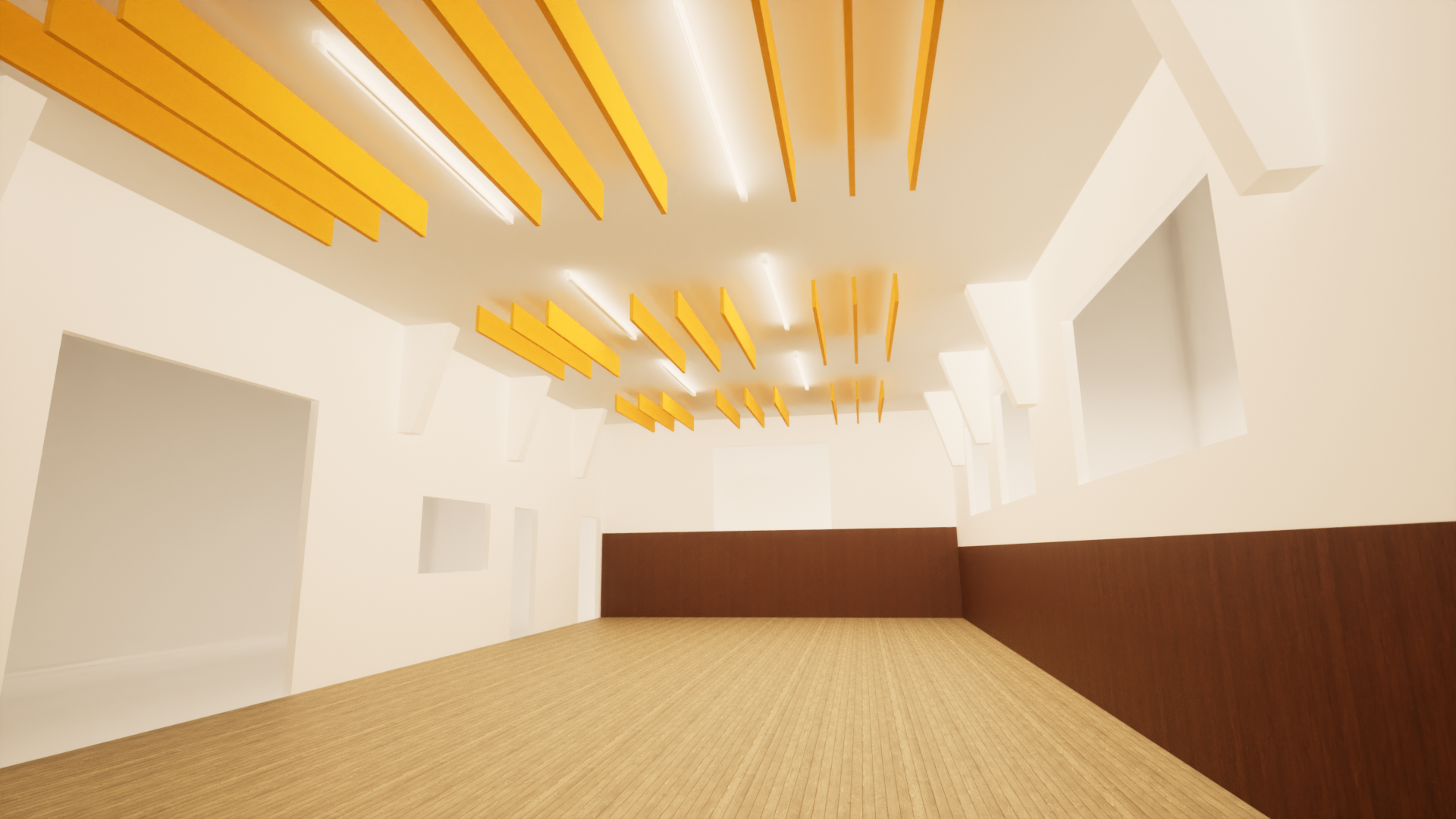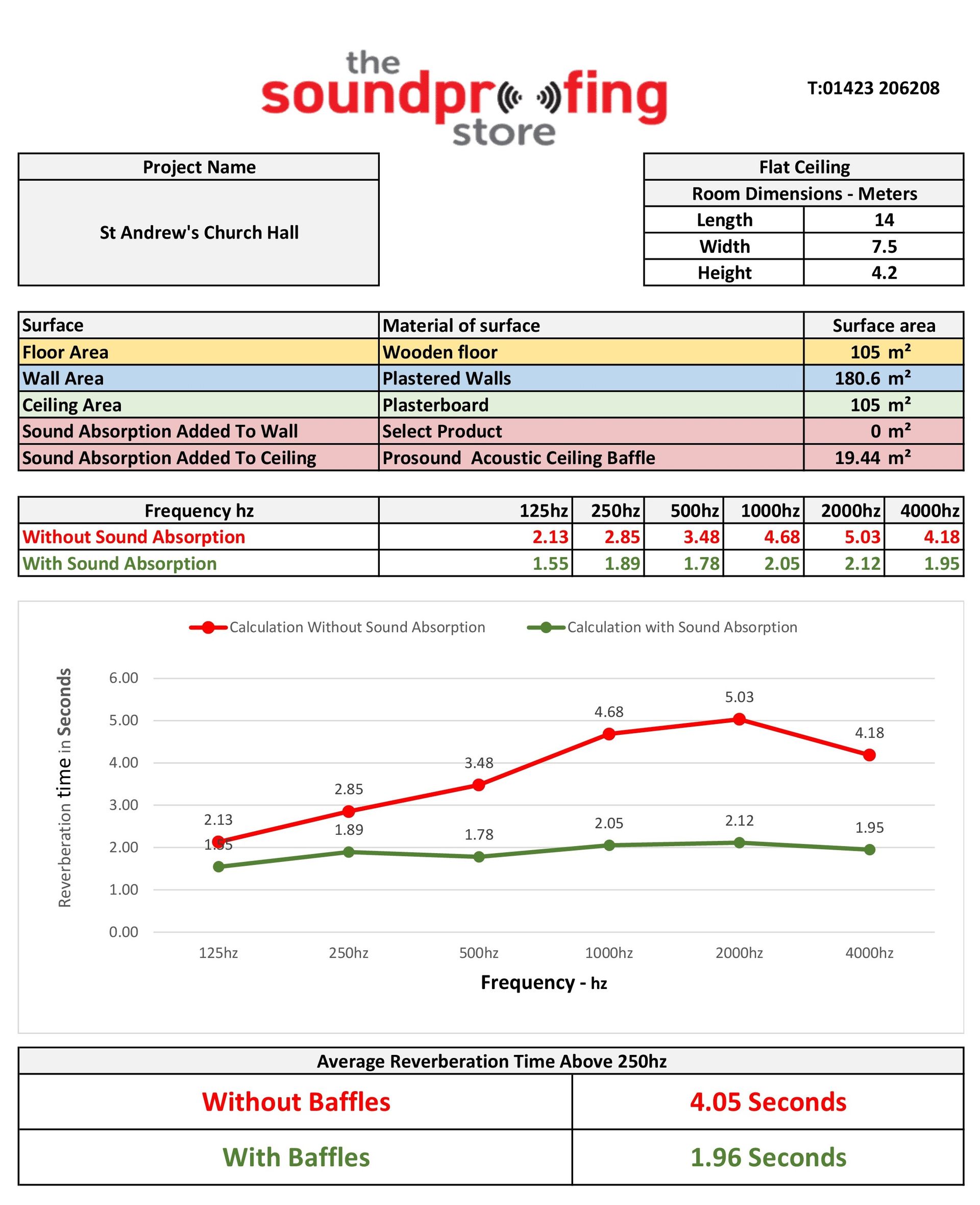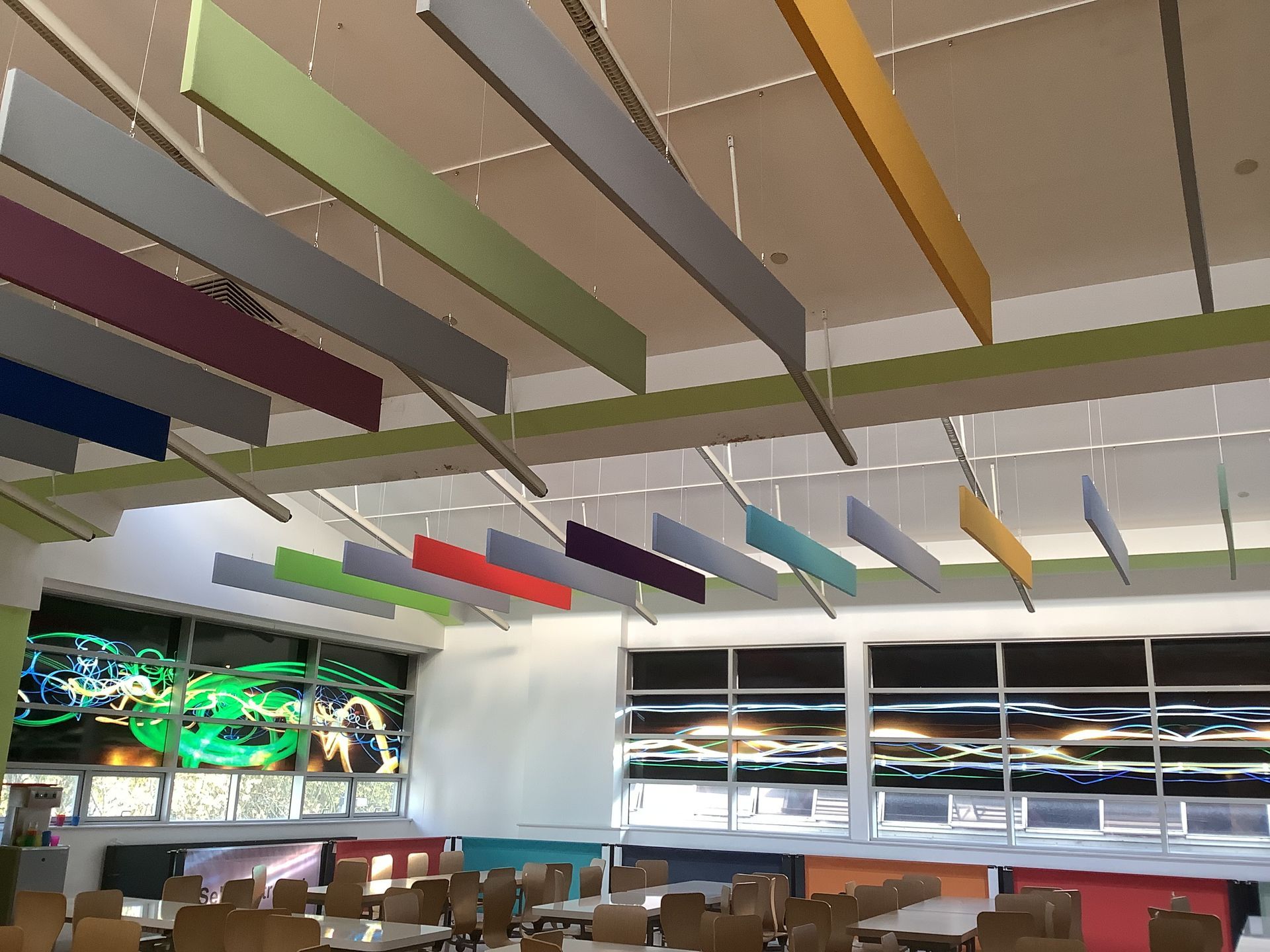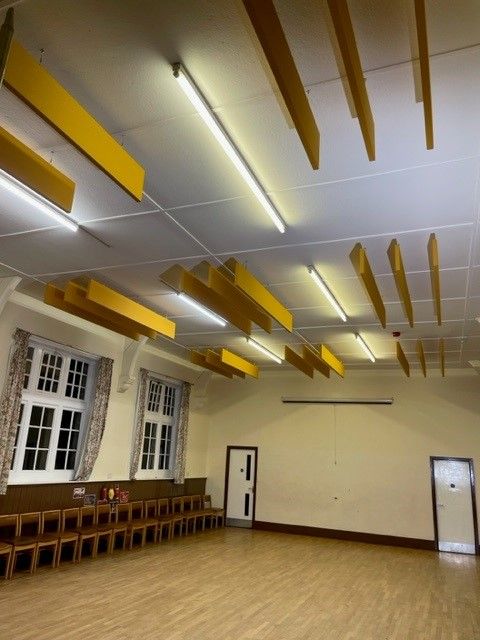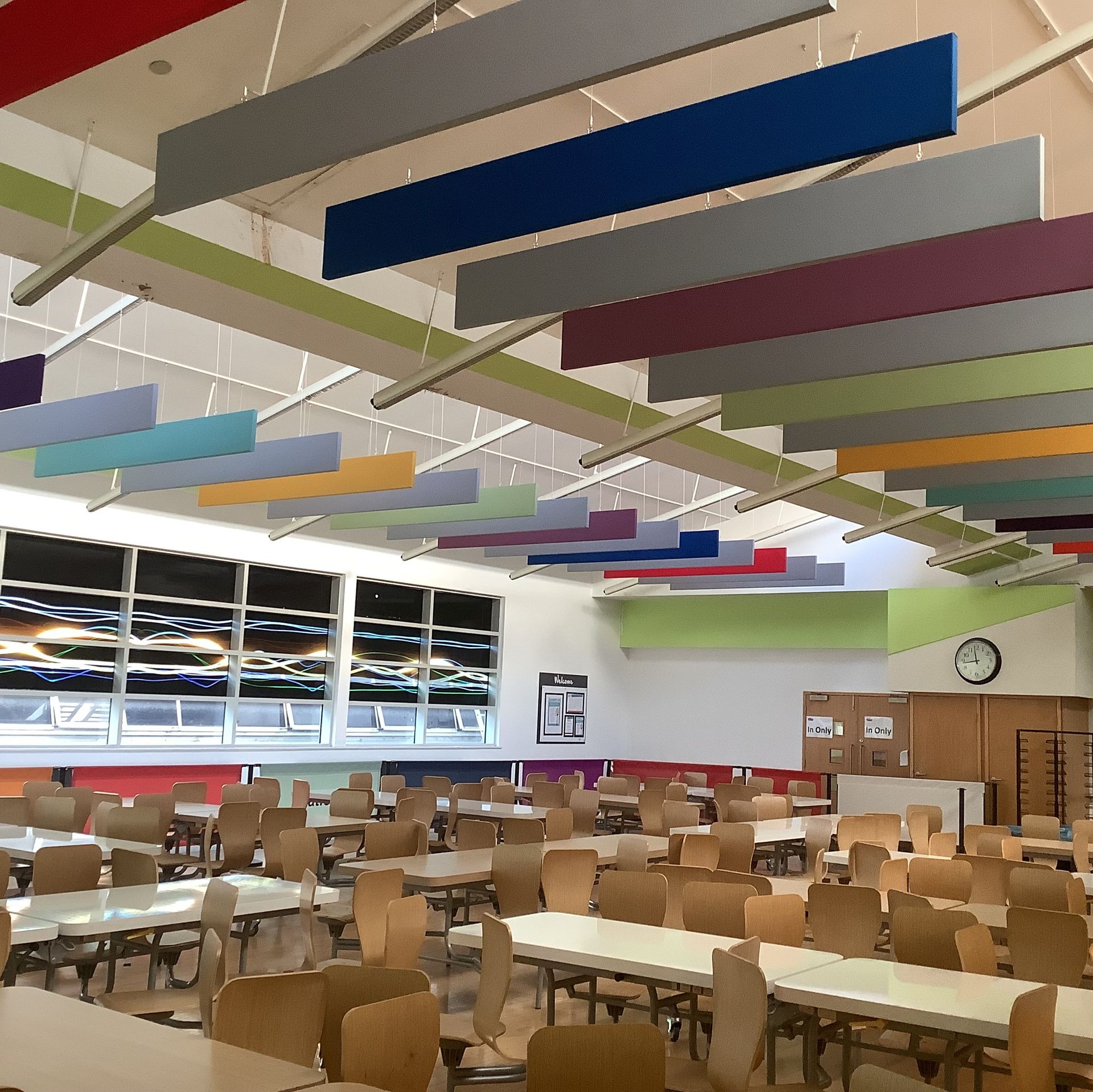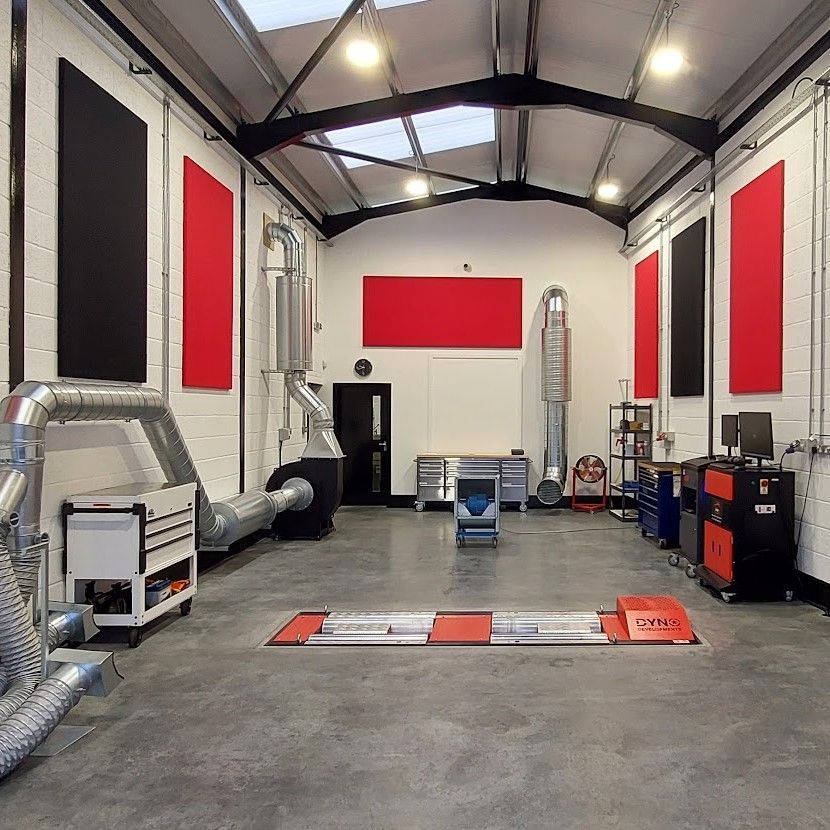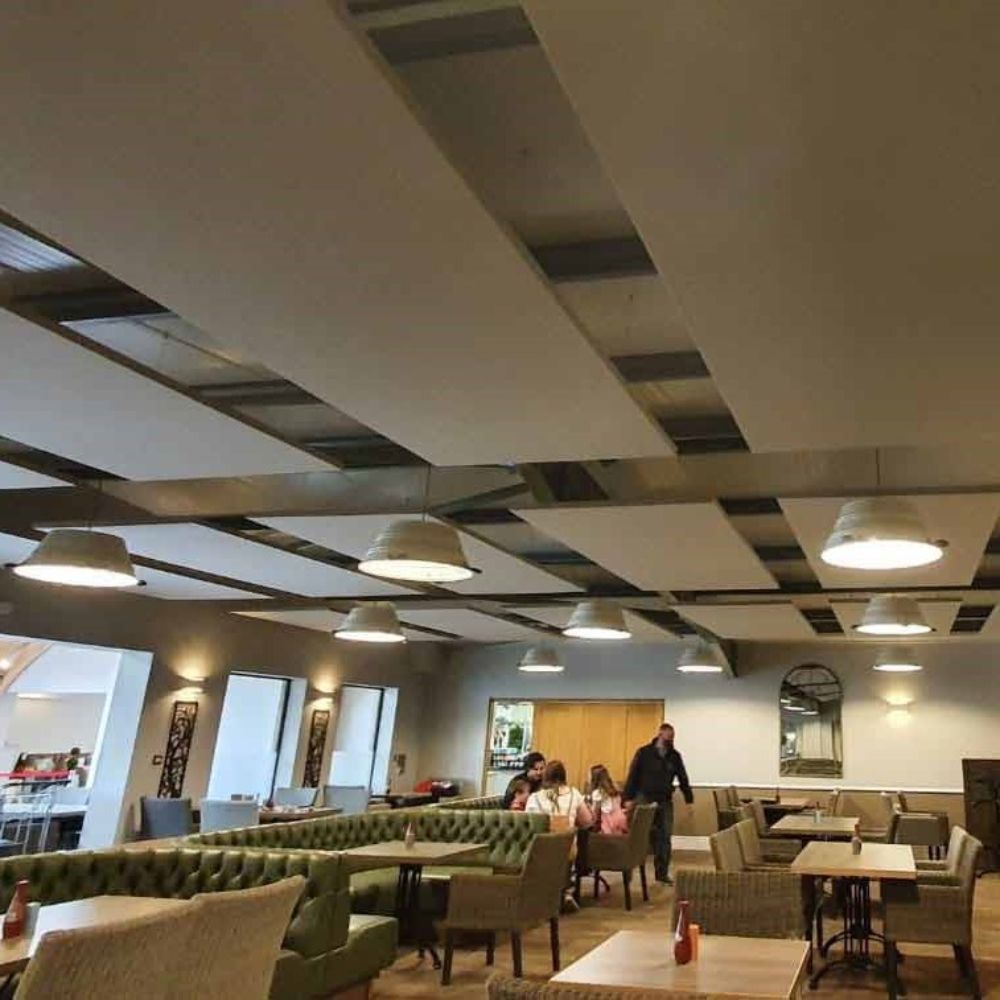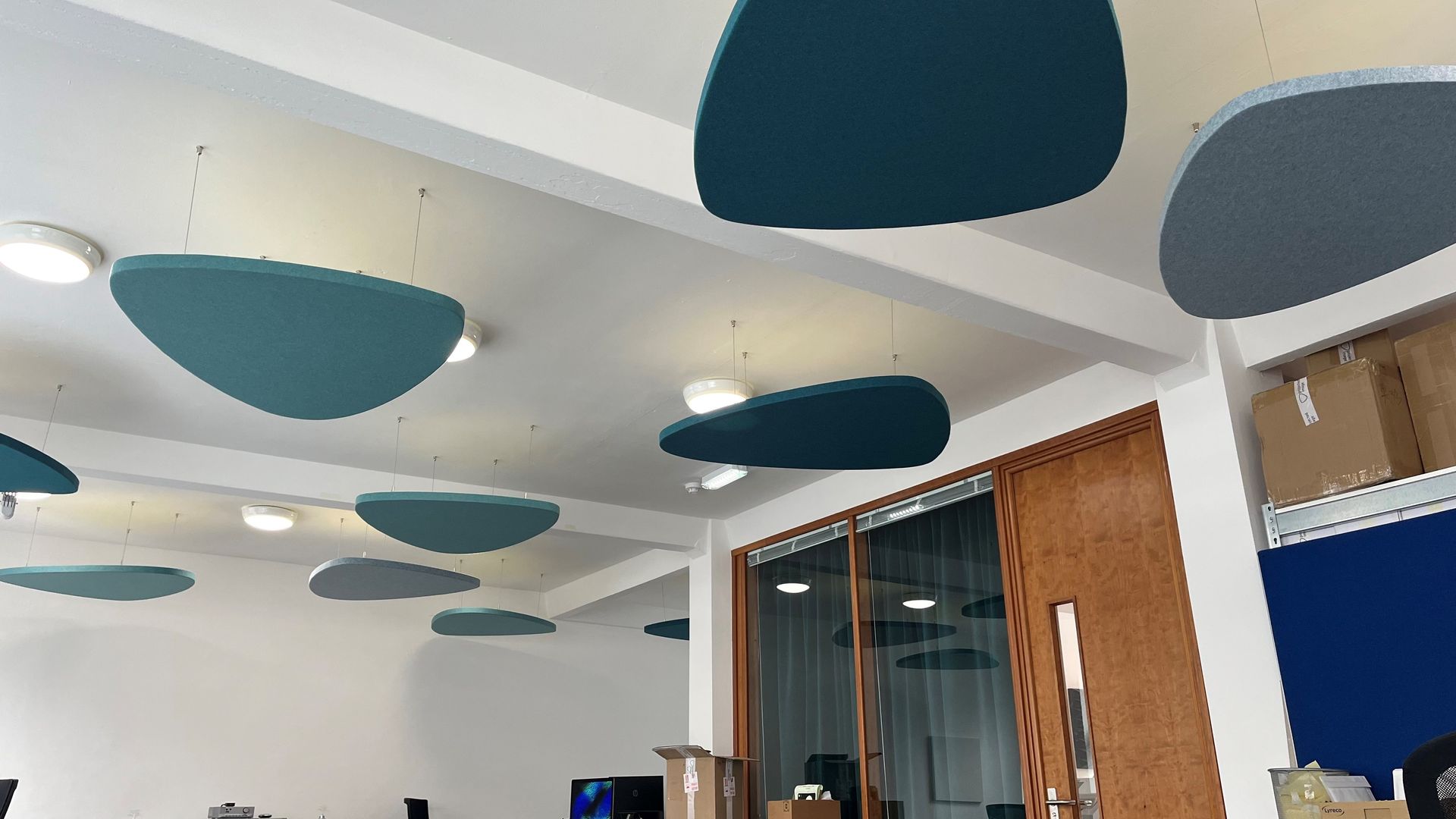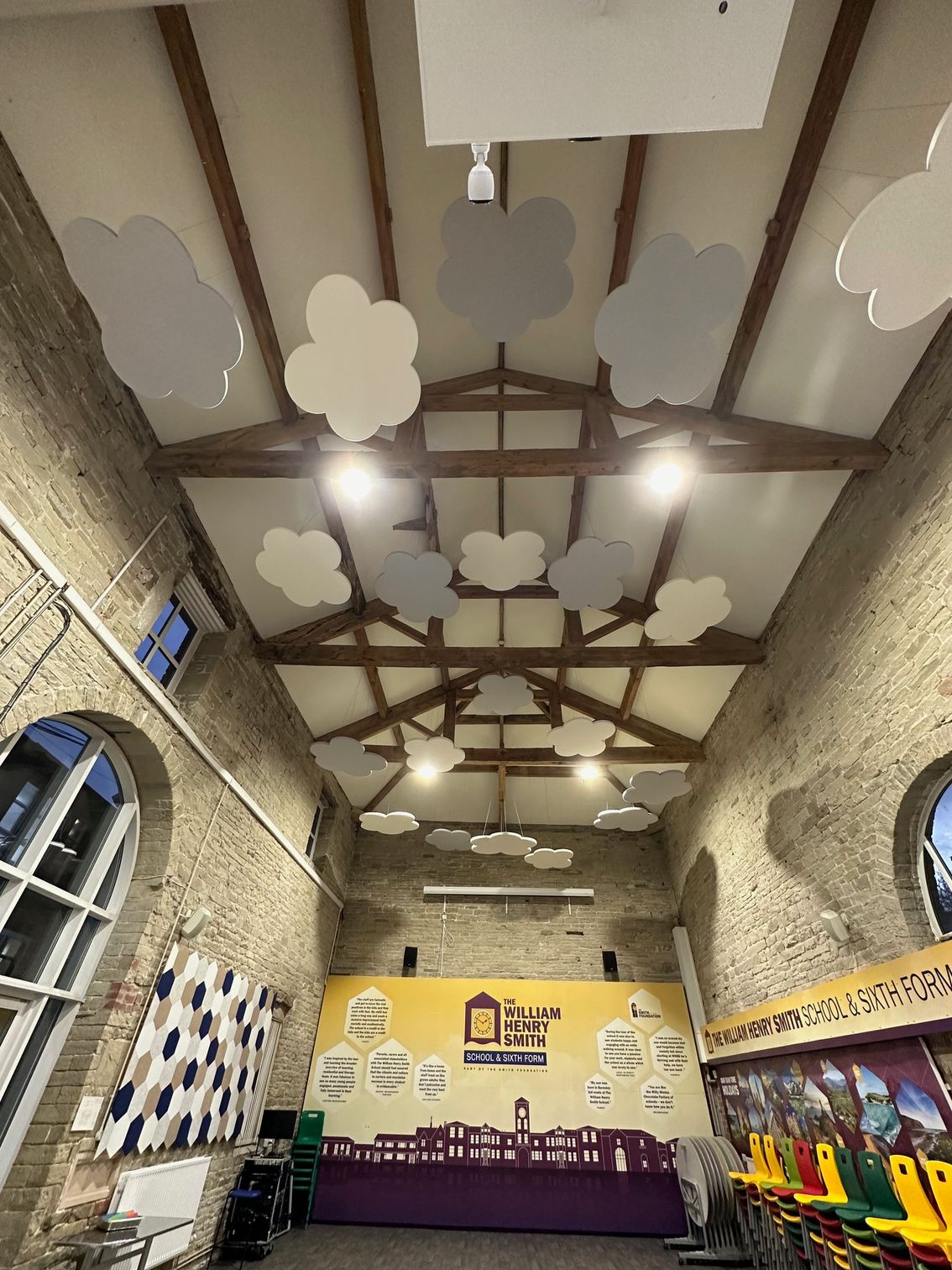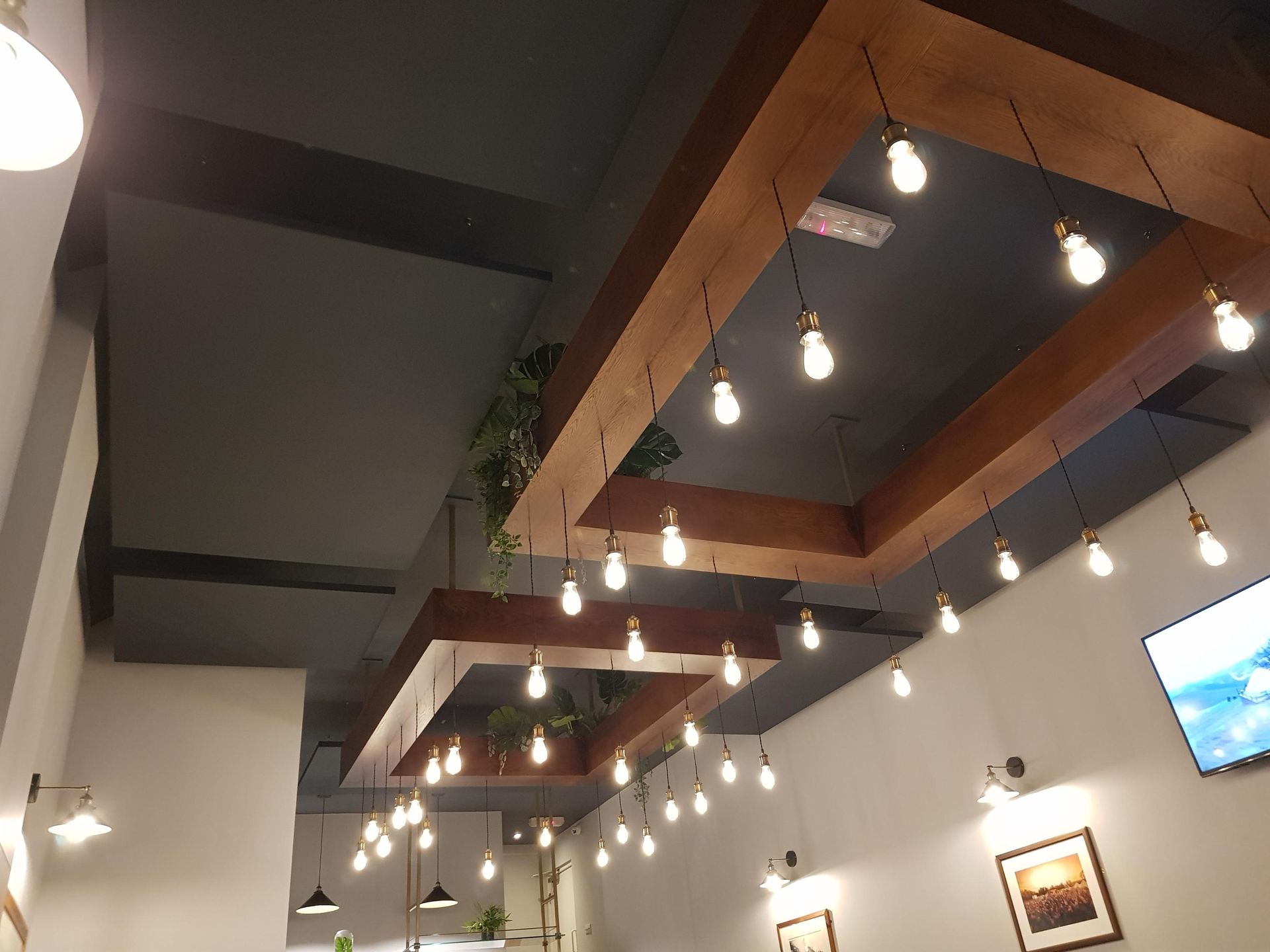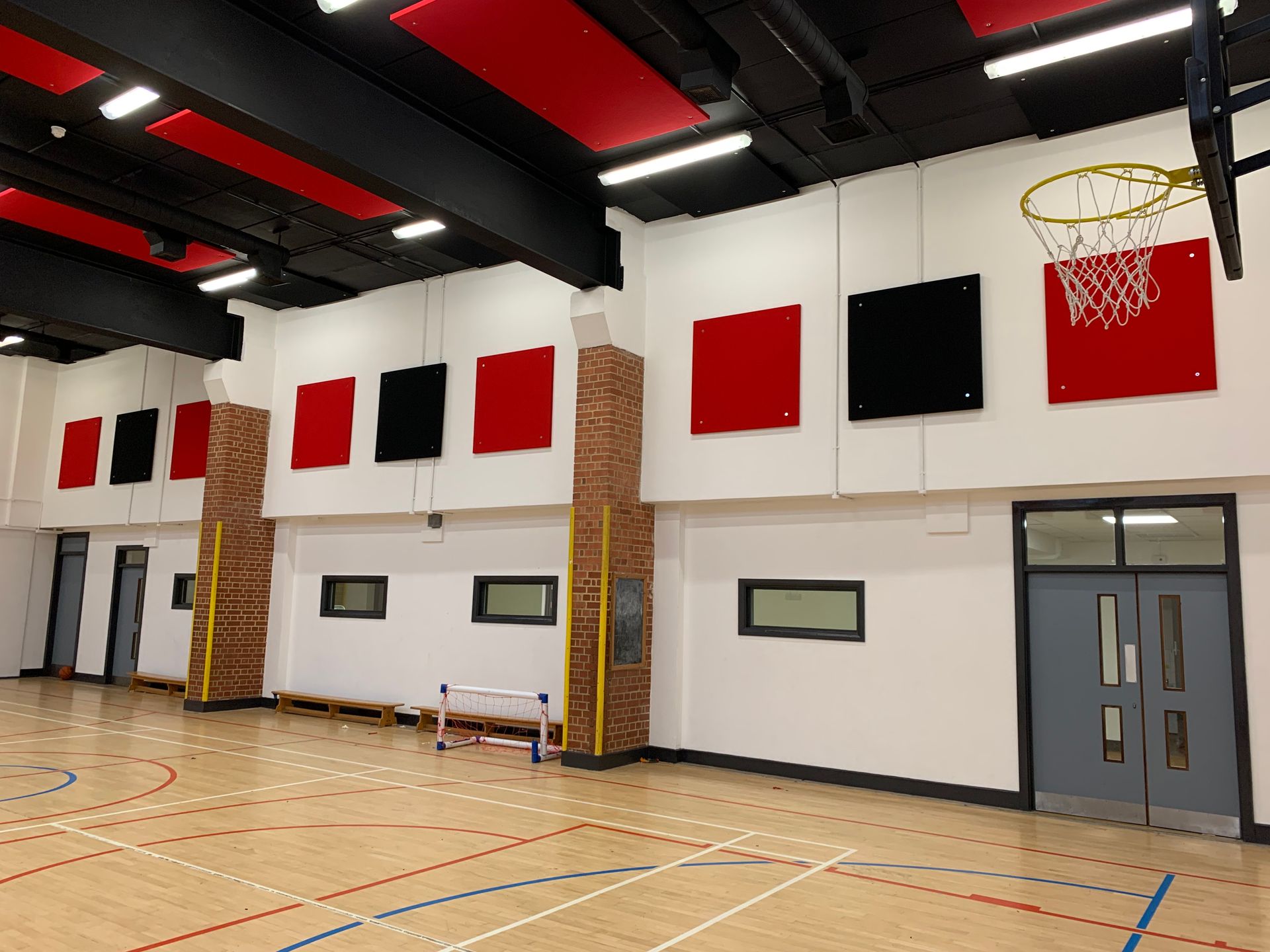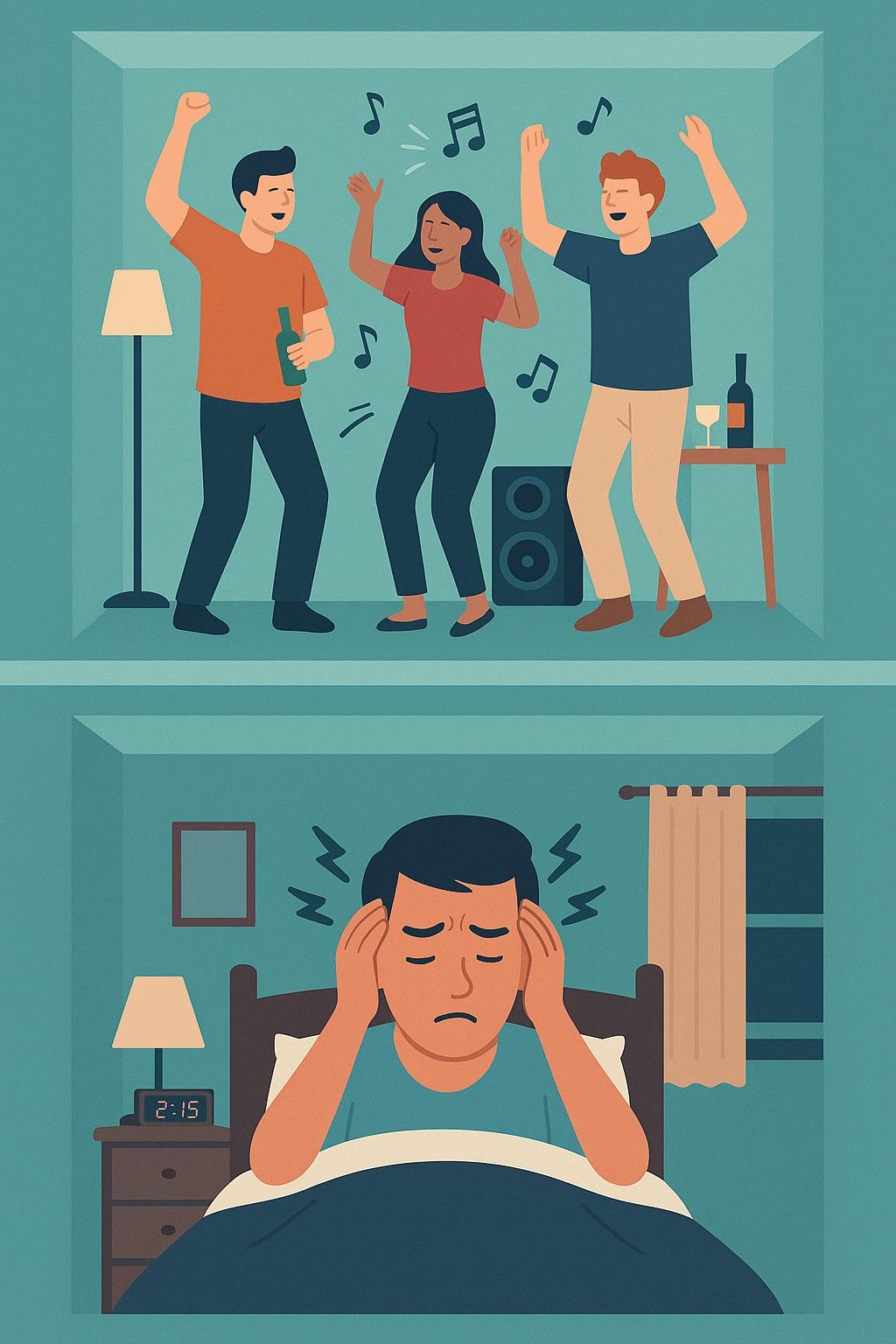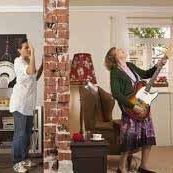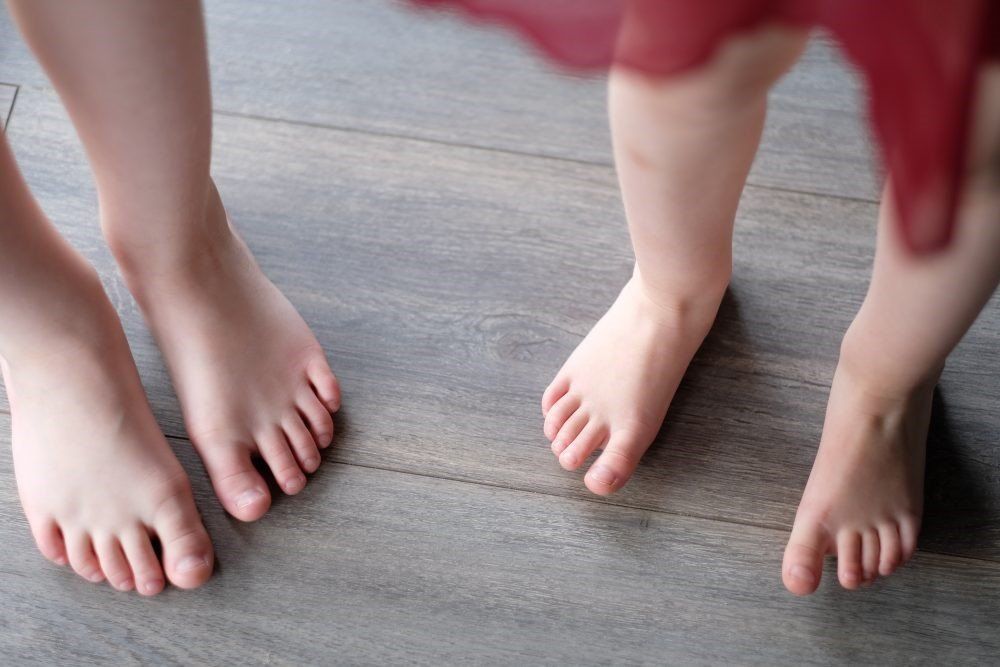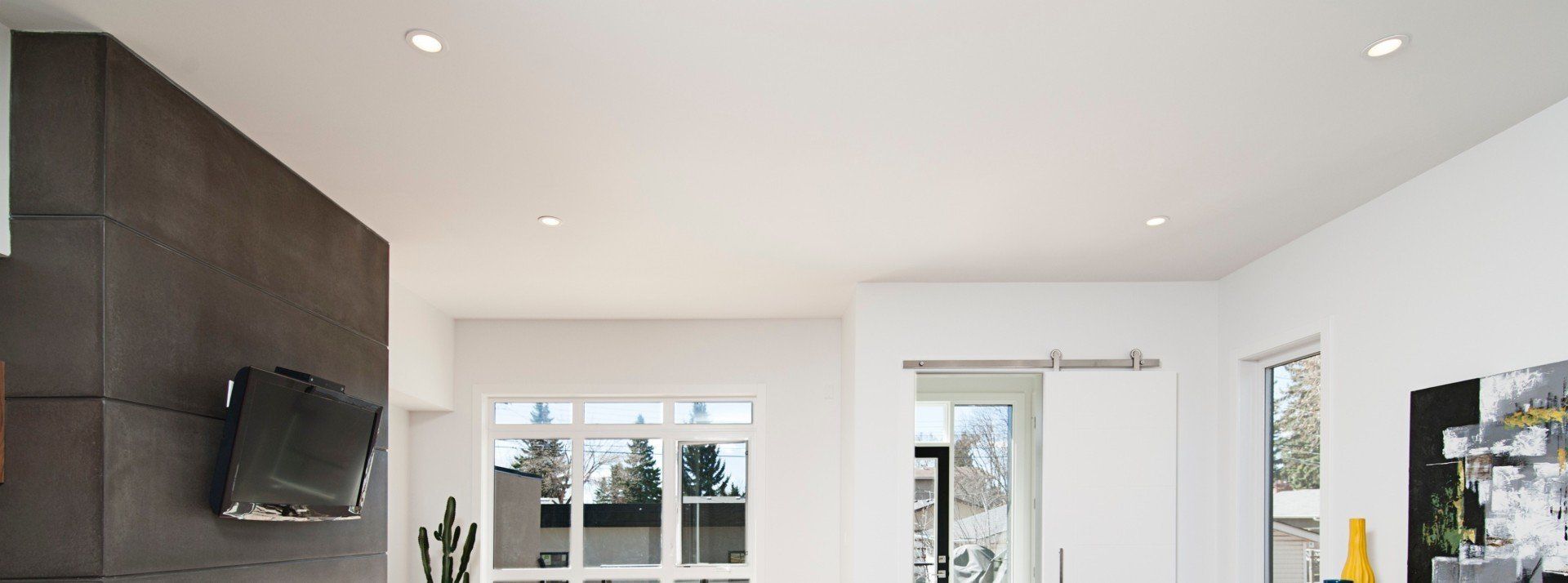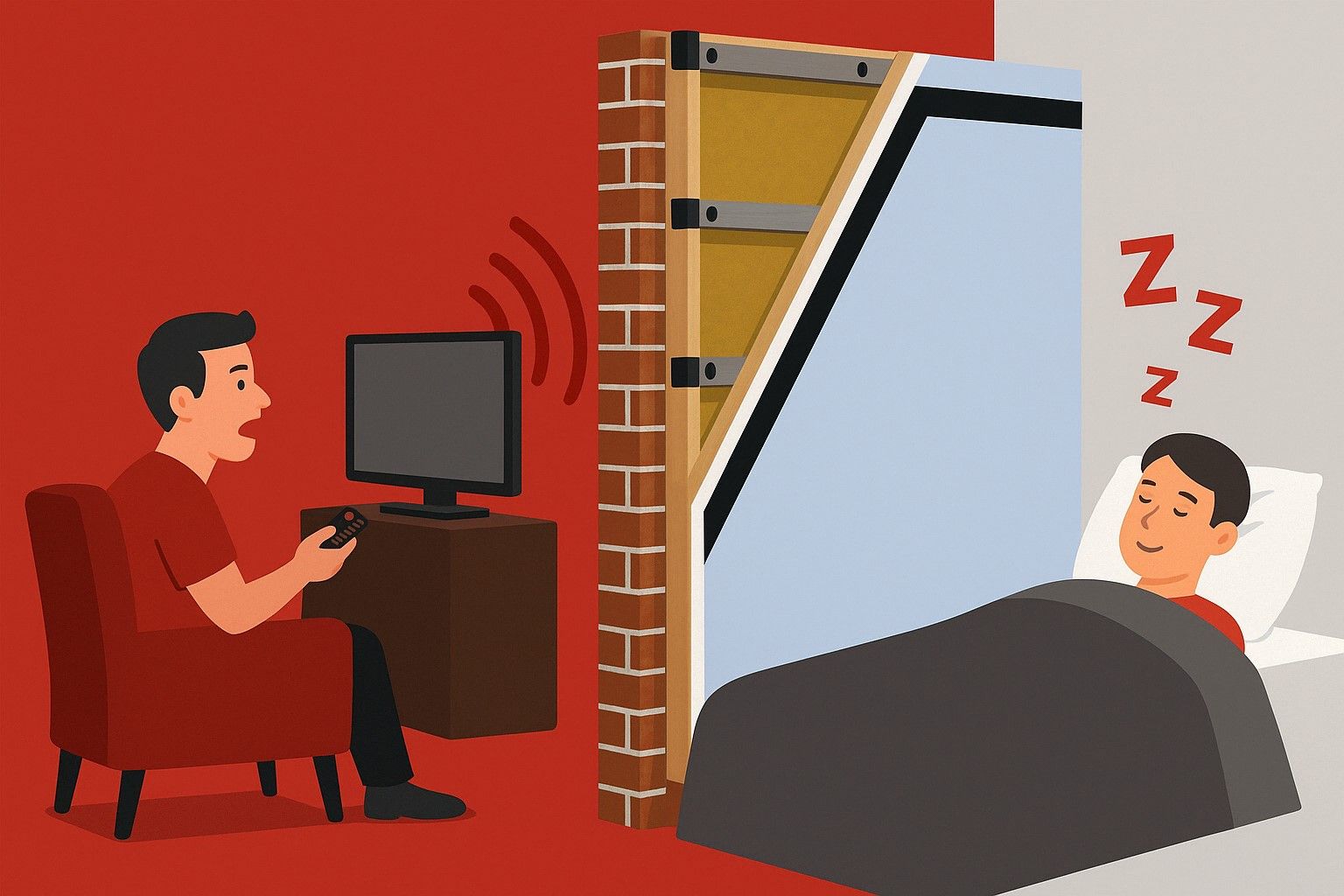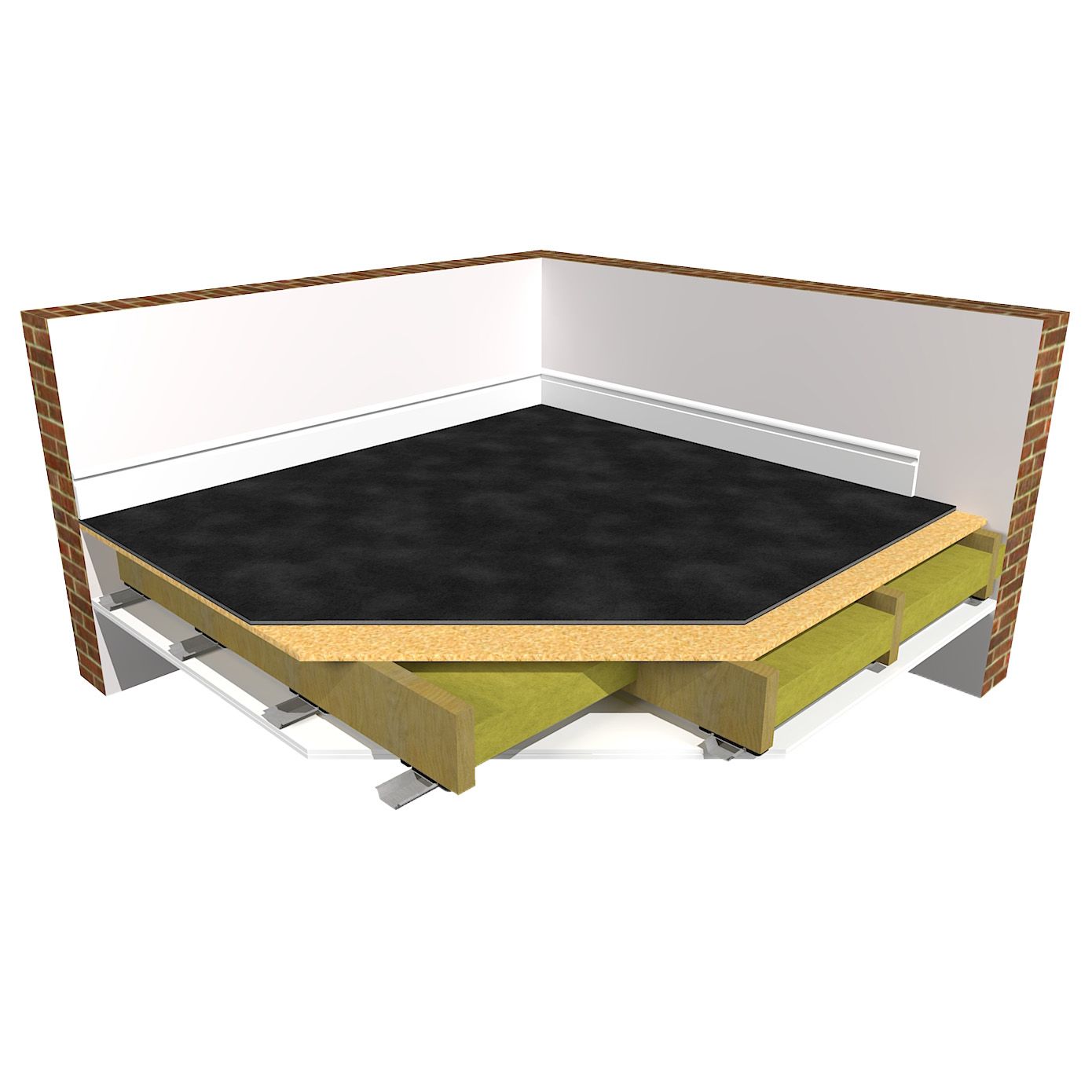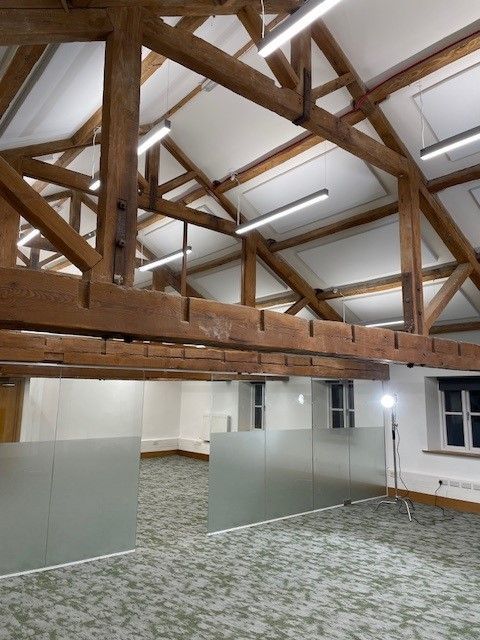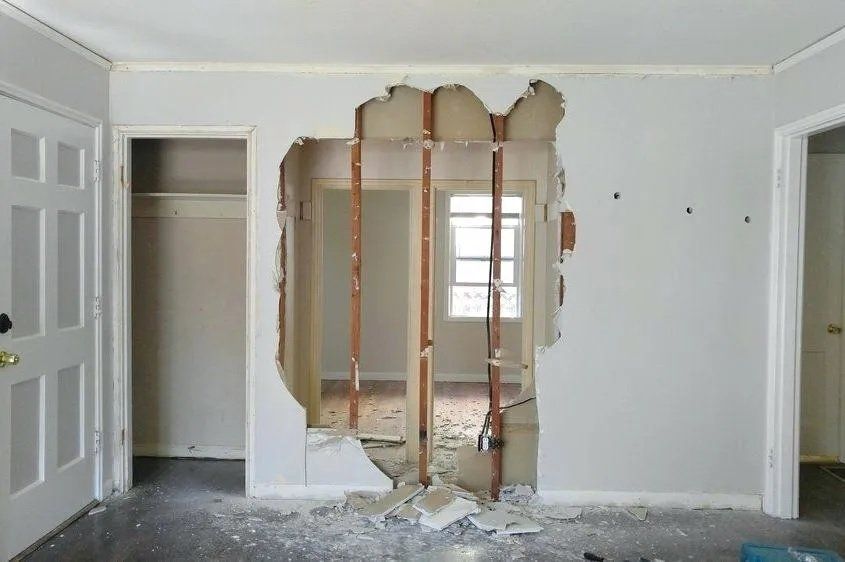How acoustic panels dramatically reduce echo
How to solve the problem of echo!
Sound absorption, or acoustic treatment is used to reduce echo and reverberation within a room.
- Acoustic panels help to reduce echo and increase the clarity of sound within any space
- Using high performing ProSound acoustic panels help to absorb echo and reverberation
- Acoustic treatment can be chosen based on the room's characteristics for example using ceiling panels if there is limited wall space or based on a personal design preference
- Acoustic options include Acoustic Wall Panels, Acoustic Ceiling Rafts, Acoustic Ceiling Baffles, Acoustic High Impact Sports Panels
- Using a high performance Class A sound absorption acoustic panel will give optimum performance in reducing echo
- Speak to The Soundproofing Store about an acoustic report which will show the improved reverberation times of the proposed sound absorption
By selecting appropriate acoustic treatment, you can easily and significantly improve room acoustics.
How to reduce echo in a church hall: Case Study
Members of St Andrew's Church in Starbeck, North Yorkshire, contacted The Soundproofing Store with a familiar concern. They were looking for a way of reducing excessive echo and noise within their church hall.
St Andrew's Church hall is regularly used for a variety of proposes, from meetings, scout groups, film nights, dance classes and events. The hall serves as a central hub to the local community and often has a number of people taking part in activities at any one time.
The committee were looking at how to solve the problem of noise and echo within the hall, which was making it hard for people to hear each other, or hear an instructor or teacher when activities were taking place.
What causes echo?
The noise problem within St Andrew's Church hall is an extremely common one. This is because within communal spaces there are often hard surfaces, such as wooden floors and solid stone walls. These are very hard, reflective surfaces (reflective from an acoustic point of view). This causes problems, because when a sound is projected e.g. when playing music or talking, the sound travels out into the room and hits one of the hard reflective surfaces and bounces back into the room again. It will then hit another surface and bounce again and with every bounce a copy of the sound is created (known as an echo).
The more echo the noisier and more amplified the sound gets. Now multiply that by having several people all talking at the same time creating multiple echoes. This often results in not being able to concentrate on the sound you are trying to listen to, as there is so much distraction with unwanted noise. Think about being in a restaurant and not being able to hear the person sat opposite you because of multiple echoes all bouncing around creating a 'messy' noisy atmosphere.
This is a problem in so many settings, not just church halls. It's the same in any shared space such as; school halls, classrooms, restaurants, meeting rooms and even open plan living spaces in peoples homes.
How to solve the problem of echo?
The most effective way of reducing echo is by using acoustic panels, often referred to as acoustic treatment, or sound absorption.
Acoustic panels are easily installed within a space and either fixed onto the walls, or suspended from the ceiling.
Acoustic panels are filled with a sound absorbing core, so once a sound is projected it travels out into the room and hits the panel and instead of bouncing back creating the echo, it stays in the panel where that sound is absorbed, converting it into a tiny amount of heat.
With the right amount of sound absorption panels for the size and shape of the room, the echo can be reduced so much so that it is no longer a problem.
Acoustic panel options
ProSound Acoustic Wall Panels
Learn MoreProSound Acoustic Ceiling Rafts
Learn MoreProSound Acoustic Ceiling Baffles
Learn MoreProSound Sports Panels
Learn MoreWhich acoustic treatment should be used to reduce echo?
Acoustic wall or ceiling panels can be used interchangeably within the same project and it really boils down to individual preference or constraints from the the shape or aesthetics of the room. For example, with the St Andrew's Church hall project it was important to keep the walls clear for notices and displays and although ProSound Acoustic Wall Panels can be used as a pin board, it is important not to cover the entire surface of the panels.
In this instance the obvious choice was to use either ProSound Acoustic Ceiling Rafts or ProSound Acoustic Ceiling Baffles which are suspended down from the ceiling to keep the wall free for their decorations and displays. The committee of the hall chose Acoustic Ceiling Baffles which offer increased coverage within the hall.
How many acoustic panels are needed to reduce echo?
By looking at pictures and dimensions of the hall The Soundproofing Store's acoustic team were able to model out the space and calculate how much echo and reverberation there is currently within the hall and how much sound absorption is needed to reduce it by a significant amount.
The acoustic report below shows how the sound within the hall can be brought down to a level where the space becomes a lot more user friendly and the echo is dramatically reduced.
Lowering reverberation times with acoustic treatment
The Soundproofing Store produced an acoustic report showing the reverberation time of the church hall (in seconds) and at different frequencies in hertz (Hz).
The reverberation time is the time it takes for the sound to dissipate by 60 decibels after the source stops. A lower reverberation time means the sound is absorbed faster and the room is quieter. A higher reverberation time means the sound lingers longer and the room is more echoey.
The below graph compares the reverberation time of the church hall without any sound absorption (red line) and with sound absorption (green line).
The green line shows the reverberation time within the church hall with the addition of ProSound Acoustic Baffles. The baffles significantly reduce the reverberation time (from 4.05 seconds to 1.96 seconds) meaning the room becomes less echoey and noisy and much more comfortable acoustically.
Acoustic Report for St Andrew's Church
Before and after acoustic sound test
What are ProSound Acoustic Ceiling Baffles?
ProSound Acoustic Ceiling Baffles are all custom made to order and made to any size or shape requirements. The acoustic baffles are wrapped in an acoustic fabric in an extensive range of colours to suit the decor, style or brand of the space. All panels are manufactured here in the UK and with extremely quick delivery lead times of 4-7 days.
Inside of the baffle is a class A absorption core, which means it absorbs a very high level of sound (90-100%) so the majority of sound that hits the baffle will stay in the baffle, instead of bouncing back into the room.
ProSound Acoustic Baffles Synopsis:
Acoustic Baffle Features
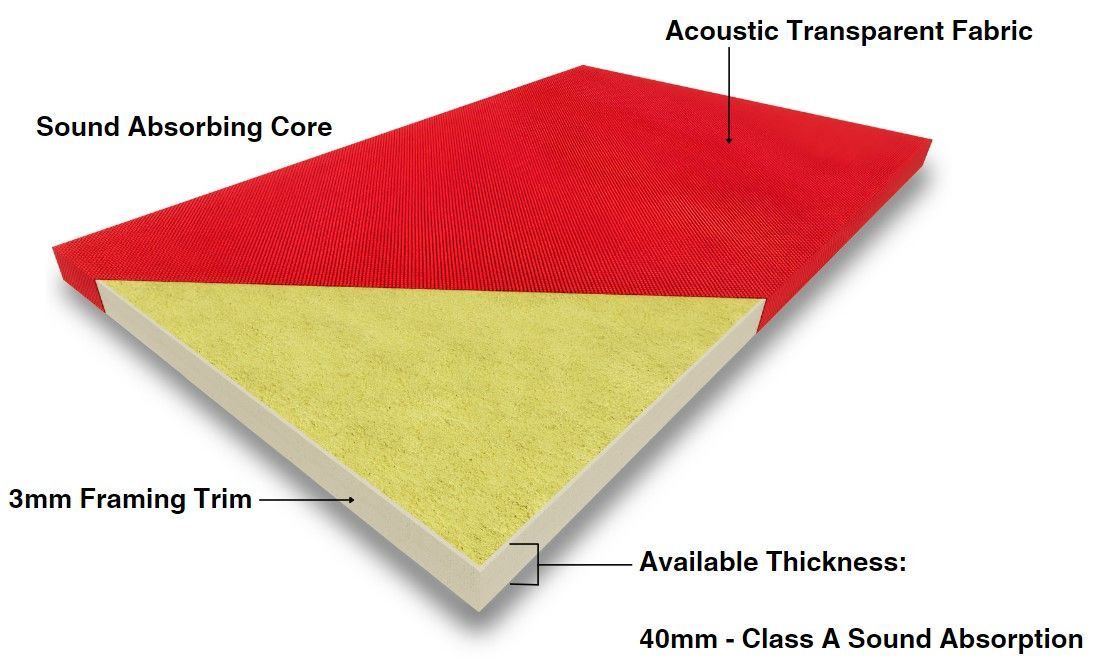 Download Brochure
Download BrochureProSound™ Acoustic Ceiling Baffles:
- Outer acoustic fabric - made to order in custom sizes and colours to fit the aesthetics of any space
- Sound absorbing core - designed to absorb sound energy (from all sides of the baffle) and dramatically improve room acoustics
- Class A (40mm thick) - delivers an outstanding performance
- Easy installation method – no specialist tools
- Supplied as standard with required amount of fixings for easy installation
- Fabric wrapped on all 4 edges with no additional trims required
- High content of recycled materials
- Used to meet BB93 Regulations
Acoustic Baffle Performance
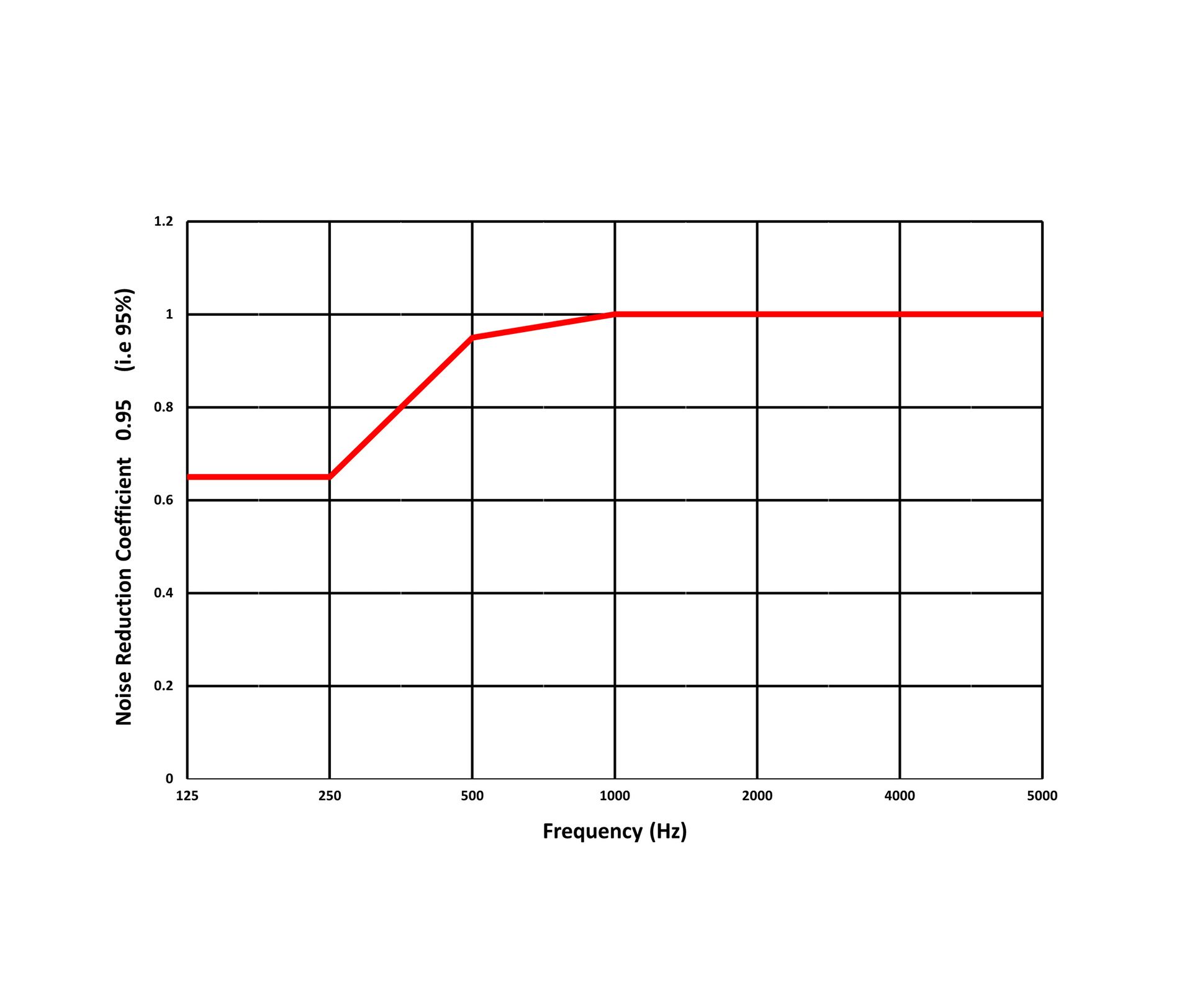 Performance Data
Performance DataAcoustic Performance BS EN ISO 354: 2003
Performance based on baffles fixed suspended from the ceiling.
ProSound™ Acoustic Ceiling Baffles:
40mm (Class A - NRC 0.95)
Acoustic Baffle Fabric Colours
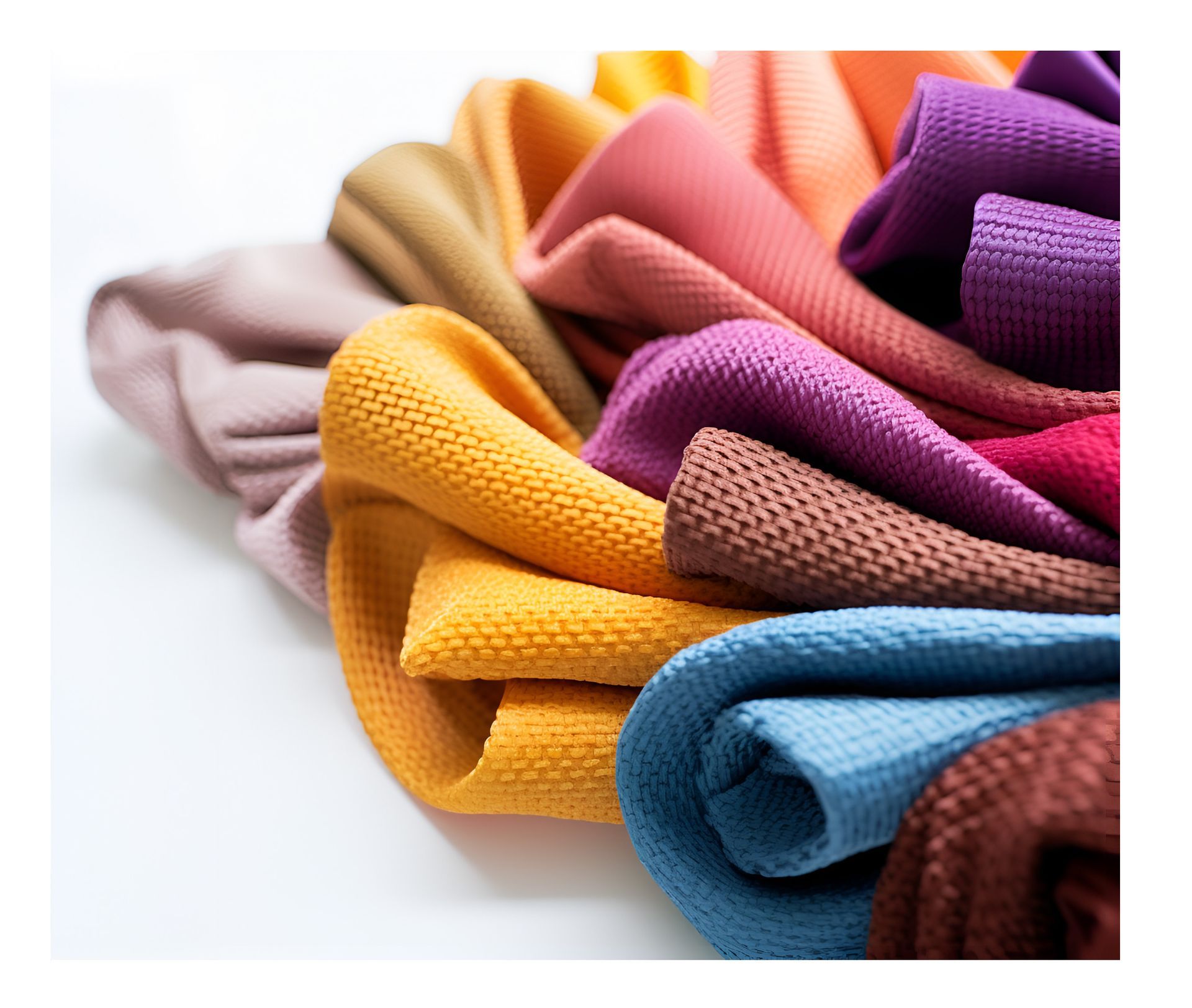 Download Brochure
Download BrochureCara is a plain weave panel fabric available in a wide selection of commercial colourways. A popular all-round fabric with a textured look designed to be used in a wide variety of settings. The matt finish makes it less reflective to light and ideal for application where video is being used.
Lucia is an ever-popular crêpe weave synthetic panel fabric. It’s manufactured from 100% recycled polyester, saving virgin raw materials and for a reduced environmental footprint. It has bold and bright colour palette to suit many designs.
Sonus is a pressed felt finish that is an ideal accompaniment for a modern interior. Its mottled colour pallet offers a wide range of colours
Acoustic Baffle Specifications
Buy NowSizes:
All ProSound Ceiling Baffles are made to order with a maximum width of 600mm and length 2.4m
In 40mm thick Class "A" Absorption
Weight:
ProSound 40 mm Ceiling Baffle weighs Approx. 4.5kg/m2
Cleaning:
Light dirt marks can be removed by using proprietary spot cleaner. A small area should be tested first before doing the full baffle to ensure that the fabric will not discolour from the cleaner.
Fire:
All standard baffle fabrics are ‘Class 1’ for the Surface Spread of Flame in accordance with BS 476-7 or to EN13501-1 - B,s2, d0
ProSound™ Panel Core Board is tested to EN13501-1 - A2 -s1, d0
Class O / EN13501-1 - B,s1, d0 covering fabrics are also available upon request
Acoustic Baffles DIY Installation
ProSound acoustic insulation products are extremely easy to install. If you have basic DIY skills then you will have no trouble installing the acoustic ceiling baffles, rafts, or wall panels yourself. As with all of The Soundproofing Store's acoustic panels, all fixing kits are fully supplied along with instructions and the sound absorption team at The Soundproofing Store are only ever a phone call away (01423) 206208.
Because the baffles are attached to the ceiling of St Andrew's Church hall, to aid installation, a scaffolding tower was hired from a local tool hire merchant. This was delivered to the church hall on the morning of the installation and picked up again the following morning.
Step-by-step installation of ProSound Acoustic Baffles
- Find the long edge of the baffle which feels softer than the other. The one without the hard edge frame, as this is the top of the baffle
- In this instance the baffles are 2.4m long which means there will be 3 suspensions installed per baffle. One in the centre and two towards the edges. The centre point of the baffle is 1200mm and this is where the first corkscrew spiral is inserted. It is simply pushed through the fabric and twisted into the core of the baffle. It is important to keep it straight, making sure the spiral does not pop out trough the face of the baffle
- The second and third spiral hooks are then inserted at 300mm from each edge
- The suspension cable is then fixed by attaching the bullet to the ceiling using appropriate fixings. (Because the baffle was being fixed into a timber ceiling, timber screws are used)
- The suspension wire is then screwed into the bullet letting the cable hang down
- The eyelet of the suspension wire is then attached to the spiral spring within the baffle
- The cable length is then adjusted using a spirit level to ensure the baffle is level. The height of the baffles can be easily adjusted by pulling the excess cable through the eyelet to lower or raise the baffle
- Once the correct height is achieved and the baffle is level, the excess wire is then simply cut with cable cutters
Improving both the sound and aesthetics with acoustic ceiling baffles
Once installed, the ProSound Acoustic Ceiling Baffles made a huge difference, not only to the acoustic quality of the church hall (as demonstrated in the earlier before and after clap test) but also visually. The acoustic ceiling baffles have given the hall a fresh and modern look and a vibrant burst of colour has really brightened up the space.
The committee members of St. Andrew's Church were delighted with the transformation of their hall. The acoustic treatment significantly reduced echo and noise, creating a more comfortable environment for their various activities and events. With improved acoustics, the church hall could now better fulfill its role as a vibrant community space and become a more commercially viable space to rent out for future events and activities.
Acoustic ceiling baffles can be used on ceilings within any space and with over 70 different colours to choose from (and with photo print options also available) there is a design to suit any room.
A summary of how to reduce echo
The noise issue in St Andrew's Church hall occurred because sound was bouncing off the hard surfaces (wooden floors and solid stone walls) which reflected, rather than absorbed the sound.
- These surfaces are highly reflective acoustically, causing projected sounds to bounce off them and create echoes within the hall
- Multiple echoes intensify noise levels, making it difficult to hear or be heard
- This problem isn't unique to church halls but extends to any kind of shared spaces like school halls, classrooms, gymnasiums, meeting rooms, restaurants, scout huts and open-plan living spaces
- The most effective solution for reducing echo is using acoustic panels, also known as acoustic treatment or sound absorption
- Acoustic panels suspended from ceilings, or installed on walls contain a sound-absorbing core that prevents sound from bouncing back into the room and effectively reduce echo
Sound absorption panels can be easily tailored to the room's size and shape and can significantly reduce echo and improve the overall acoustics and aesthetics.
Examples of acoustic panels
Acoustic panels are available in a range of colours, shapes, and sizes. If you're seeking to minimise echo and reverberation in any space, The Soundproofing Store is here to help you.
Simply get in touch with your room dimensions and any images of the space and The Soundproofing Store will work out the correct amount of sound absorption panels needed.
Acoustic Panels FAQ's
How do acoustic panels work?
Learn MoreAcoustic panels work by absorbing sound waves. The absorbent core used in ProSound Sound Absorption Wall Panels, Ceiling Rafts and Baffles are all designed to absorb sound energy. This means when a sound wave hits the panel it stays there and doesn't bounce back into the room.
This helps to reduce echo and reverberation and dramatically improves the clarity of sound within any space.
How many acoustic panels will I need?
ContactThe quantity of panels, rafts, or baffles required depends on factors such as the room's dimensions, surface material, and reverberation time.
The Soundproofing Store calculate the correct number of panels needed to reduce the reverberation time accordingly.
Are acoustic panels easy to install?
Installation VideoProSound Sound Absorption Wall Panels, Ceiling Rafts, and Baffles are extremely easy to install.
They are a DIY installation and The Soundproofing Store provide step-by-step installation guides and videos and are only ever a phone call away.
Alternatively, a local tradesperson or someone with basic DIY skills will have no problem installing the acoustic panels.
Do egg box foam acoustic tiles work for sound absorption?
Learn MoreNo!
In contrast to ProSound Class A panels, these fall short of classification standards. Consequently, a significant amount of the sound directed at them still rebounds back into the room, making no difference to the improvement of the room's acoustics. (To achieve only a reasonable improvement the whole room would need to be covered in them!)
The quality of cheap foam panels is also questionable and can vary considerably in thickness and shape, even among panels within the same package.
Aesthetically, they also lack visual appeal compared to ProSound panels, which are modern, smart and bespoke. ProSound panels come in a range of colours and shapes. Bespoke printing options also mean the panels can be fully customised to enhance any space.
Author
Sam Fessey heads up the Sound Absorption department within The Soundproofing Store. With a huge amount of experience in acoustics, his extensive knowledge is invaluable in working with all types of settings in helping to transform noisy environments into peaceful, productive spaces for people to enjoy.
Share
"We don’t expect you to become an overnight expert in sound absorption, that’s what we’re here for."
